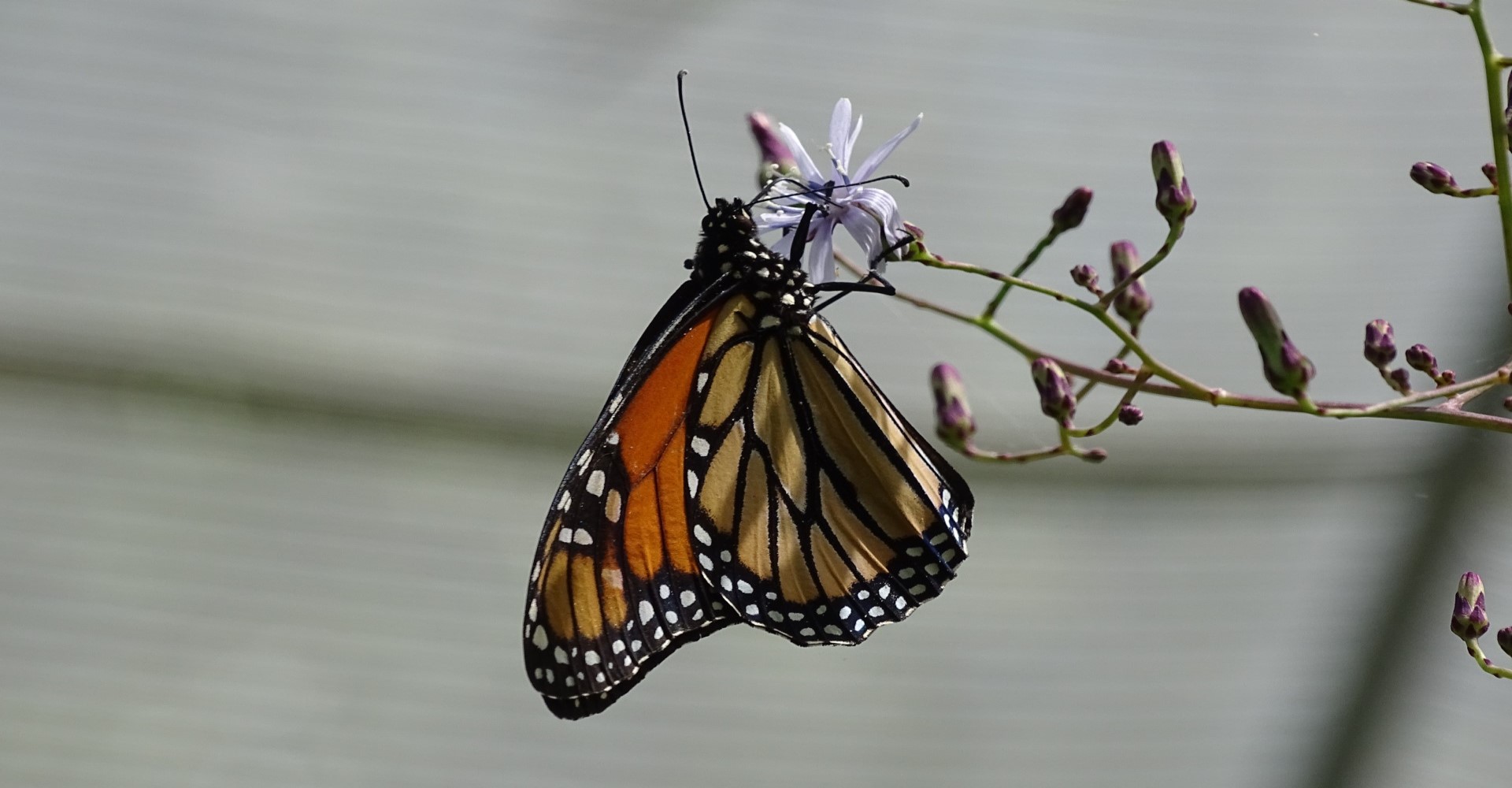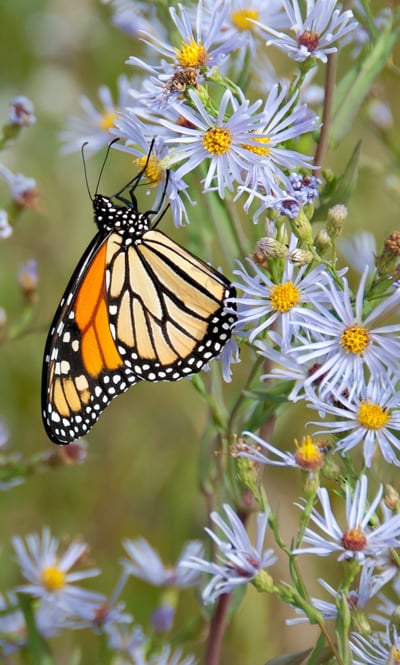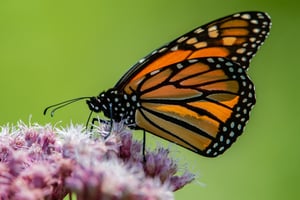
The monarch butterfly is a threatened species that serves as a litmus test for the environment. Is it possible that they could make a recovery? And if so, what does that say about our environmental efforts? Join us for the second installment of two-part series.
Download the free PDF to share with your friends and colleagues here!
The monarch is a quintessential butterfly. From grade school classroom projects to bestselling books such as Barbara Kingsolver’s Flight Behavior, this North American species has made a significant impression on those of us who live there.
Yet not significant enough. With population numbers down 80-90 percent in the past two decades, monarchs are in major peril. We’re not helpless, though. In fact, there’s a whole lot we can do for these orange-and-black beauties, according to Plant Ecologist Elizzabeth Kaufman of Pollinator Partnership, with whom we were lucky enough to score an interview.
If you missed the first part of the series, we highly recommend you go check it out now and get the brief low-down about why monarchs are struggling and what the means for humans and the environment. If you’re all caught up, read on and learn how to save this important pollinator today!
Create More Habitat in ALL Sectors
 First and foremost, monarch butterflies desperately need more habitat for all stages of their life cycle. As Kaufman shared in the last post, “The greatest challenge to monarch conservation is being able to restore enough quality habitat to be able to support a viable population despite enormous habitat loss,” Kaufman says. “Habitat loss and fragmentation are among the greatest threats to all pollinator species as well as all other forms of wildlife.”
First and foremost, monarch butterflies desperately need more habitat for all stages of their life cycle. As Kaufman shared in the last post, “The greatest challenge to monarch conservation is being able to restore enough quality habitat to be able to support a viable population despite enormous habitat loss,” Kaufman says. “Habitat loss and fragmentation are among the greatest threats to all pollinator species as well as all other forms of wildlife.”
Although destruction of habitat through agriculture and development is hard to overcome, there’s plenty we can do.
Those in the agricultural sector can, for instance, plant the margins of their fields with milkweed and other nectar-producing species that give monarchs a place to rest and eat. As a bonus, Kaufman says, this also supports beneficial insects that can reduce the need for herbicides and pesticides in fields, which in turn reduces stress on butterflies. Since those margins aren’t in production anyway, there’s no need to give anything up.
“For crops that aren’t dependent on pollinators, such as soy,” Kaufman says, “you will still attract beneficial predatory insects and reduce the need for pesticides. They will go out and eat, for instance, soy aphids.”
You don’t have to be a farmer to help, though. We need milkweed and other butterfly-supporting plants in as many places as possible, including:
- Homes and businesses
- Schools and other public buildings
- Rights of way and easements
- Community gardens
- Conserved land
Encourage Year-Round Monarch Butterfly Recovery Through Pollinator-Friendly Plantings
 Supporting monarchs is totally possible right at home. Monarchs, after all, need a lot of habitat to make up for all that lost prairie.
Supporting monarchs is totally possible right at home. Monarchs, after all, need a lot of habitat to make up for all that lost prairie.
“The USGS came up with an estimate that we need to restore between 1.3 and 1.8 billion stems of milkweed within the Midwest, the monarch’s primary breeding habitat, to stabilize the population and prevent extirpation,” Kaufman says, so every little bit helps. “If you have limited space, plant a small garden. If you have larger space available, plant more.”
Milkweed is required for monarch reproduction, but native wildflowers which provide nectar for adult butterflies are essential as well. Make sure, too, to plant wildflowers that bloom throughout the seasons, from spring into late fall. Kaufman explains that late fall is “a critical time for the southern migration. They’re flying up to 3,000 miles, from Southern Canada and the Northern U.S. all the way back to the Central Highlands in Mexico.”
To that end, she says, “We advise people to use a minimum of three different blooming species per season, and to incorporate bridging plants to provide vital nectar, and pollen for bees, between seasons so that floral resources are available throughout spring, summer, and into late fall.” (You can download a guide to your planting zone here.)
One last caveat: Steer clear of cultivars. “While a cultivar might be beautiful, it’s always best to go with tried-and-true native species,” Kaufman explains. “Pollinators have evolved over millennia with native plants and these plant-pollinator relationships are complex. When you consider life on the evolutionary timescale, planting novel species that we developed in recent times for particular characteristics that appeal to us, those may not provide the same quality resources for wildlife as do plant species that co-evolved together with pollinators.”
Become a Citizen Scientist and Add to the Monarch Butterfly Knowledge Base
 You can also join initiatives such as Project Wingspan, which is dedicated to creating pollinator habitat. The project, according to the website, “is leading a coalition of partners in an effort to enhance land across the Midwest to support our imperiled pollinators.”
You can also join initiatives such as Project Wingspan, which is dedicated to creating pollinator habitat. The project, according to the website, “is leading a coalition of partners in an effort to enhance land across the Midwest to support our imperiled pollinators.”
Their mission is to engage “public land managers and private land stewards throughout the 8-state target region of Arkansas, Illinois, Indiana, Michigan, Missouri, Ohio, Pennsylvania, and Wisconsin through a series of monarch habitat enhancement activities with the goal of enhancing and securing 10,000, acres of high-quality monarch and [Rusty Patched Bumble Bee] habitat.”
The purpose of the program, Kaufman explains, is “to quickly and rapidly develop a supply of local genotype seed, which is seed that inherently has genetics specifically adapted to local environmental conditions, for restoration projects across the Midwest and Great Lakes landscape.” (Each state is divided into two to three seed collection and re-distribution zones.)
They work with volunteers all across the region to collect, geotag and clean seed. They then distribute seeds and plugs back to the regions from where they were collected, creating native habitats for the pollinators that live there, monarchs included.
You can help in a number of ways:
- Collecting seed
- Monitoring monarchs through counting eggs, caterpillars and adults
- Monitoring disease outbreaks
“It is impressive mobilization, and really restores one’s faith in humanity, because the participation level has been so phenomenal,” Kaufman enthuses. “It has really engaged people at so many different levels. Such a range and diversity of educational, socioeconomic, and political backgrounds, and multiple organizations and agencies are involved. The monarch has become a really great ambassador for the conservation of many pollinator species and for the restoration of native habitat.”
If you want to get involved, check out the Project Wingspan web page to learn more. If you’d rather learn about planting a butterfly garden in your own yard, we invite you to get in touch with Ecogardens today.

